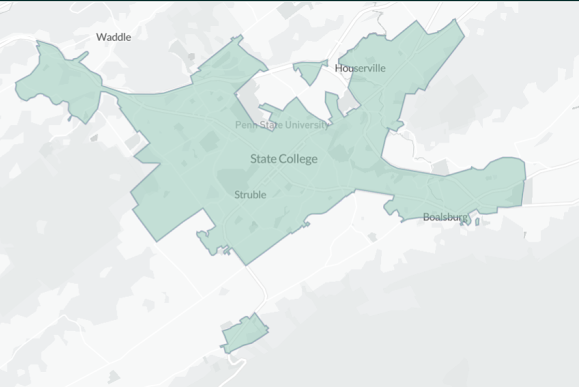Sidewalk Cracks: Oddities of Pedestrian Infrastructure
Written by Anne Johnson
An approximately 100 yard gap in the sidewalk along Toftrees Avenue in Patton Township. If you look closely, you can see the sidewalk start again just beyond the mailbox.
Fall is one of my favorite times of year to walk, with the temperature perfectly cool, the new colors of the leaves, and a sense of the world changing around me. Thus, when I needed a quick break this weekend, I decided to go for a stroll and enjoy some of the last nice weather of the year. As I was walking along Toftrees Avenue in Patton Township, I came to an area where the sidewalk abruptly ended, and then picked up again perhaps 100 yards ahead. This seemed quite odd to me, so I decided to find out why.
Turns out that in Patton Township, as in the Borough of State College, College Township, Ferguson Township, and many other places throughout the United States, the maintenance and construction of sidewalks is the responsibility of the owner of the property beside the sidewalk. While Patton Township requires most landowners to have a sidewalk along the side of a public street, this does not apply to land that is zoned as Rural, Rural Residential, Natural Resources, Floodplain, or University District, as, by the township, “these areas are viewed as not typically generating enough pedestrian movement to warrant sidewalks.” Unlike the majority of land along Toftrees Avenue that is zoned as a Planned Community, the one property that this gap is alongside is considered Rural Residential.
A map of the Patton Township zoning along Toftrees Avenue. The land colored light blue is zoned as Planned Community, the darker blue as University District, and the yellow as Rural Residential.
I fully understand the decision of the property owner to not add a sidewalk when not required to; to build a sidewalk 5 feet in width as required by Patton Township in this area would likely cost around $13,500 just to install, with additional costs for things like snow removal and maintenance once it was in. What concerns me most is the clear disregard by local governments for the people for whom sidewalks are vital. Despite the claims they make, with State College’s description of their sidewalk project reading “State College Borough is a community that prides itself on safe and pedestrian-friendly sidewalks'' and the section of College Township code addressing sidewalks beginning “it is the intent of College Township to provide for a safe and convenient sidewalk system in appropriate areas of College Township to create a pedestrian friendly environment,” it is hard to believe that sidewalks and other pedestrian infrastructure is actually a priority when construction and maintenance is put on individual landowners while vehicle lanes are paid for using government funds.
I did what many pedestrians do at this point on Toftrees Avenue; I walked on the grass to where the sidewalk resumed. But this solution will not work for everyone - not for those reliant on sidewalks due to physical or visual disabilities, and not for those who need to cross this space when winter brings snow and ice. What we truly need is to prioritize sidewalks more and make sure the needs of our pedestrians don’t fall through the cracks.




Comments
Post a Comment